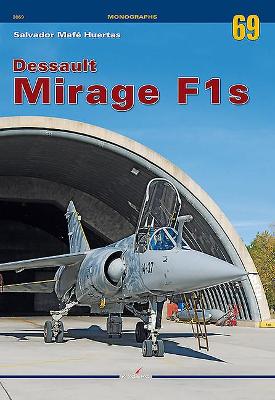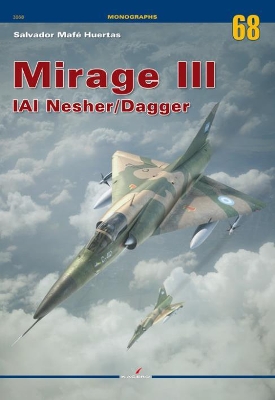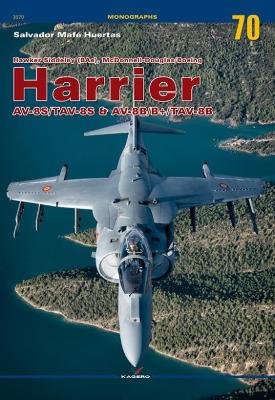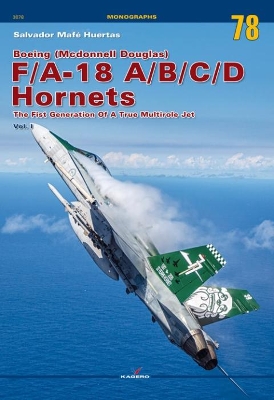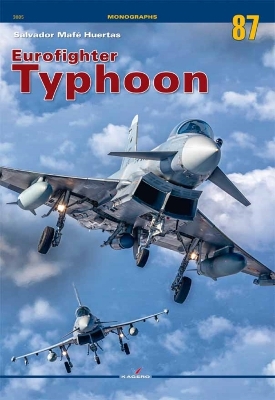Monographs
7 total works
The Mirage F1 emerged from a series of design studies performed by French aircraft manufacturer Dassault Aviation. Having originally sought to develop a larger swept wing derivative of the Mirage III, which became the Mirage F2, to serve as a vertical take-off and landing (VTOL) propulsion testbed akin to the Dassault Mirage IIIV, however, it was soon recognised that the emerging design could function as the basis for a competent fighter as well. Both the Mirage F2 and a smaller derivative, referred to the Mirage F3, received substantial attention from both Dassault and the French Air Force, the latter being interested in its adoption as a long-range fighter bomber as a stopgap measure prior to the adoption of the envisioned Anglo-French Variable Geometry (AFVG) strike aircraft.
Parallel with the Mirage F3 study, which was intended to serve as an interceptor aircraft, Dassault decided to study a single-seat derivative which featured the all-French SNECMA Atar 9K-50 turbojet engine. The Spanish Air Force was the second Mirage F1 customer, and purchased a total of 91 machines of different variants from 1975, equipping a total of four squadrons, during the period 1998-2000, the survivors were upgraded to Mirage F1M standards, and were phased out of service in June 2013, but about 22 of them were given a new lease of life after beinjg acquired by Draken International to be used as aggressors in the US.
Parallel with the Mirage F3 study, which was intended to serve as an interceptor aircraft, Dassault decided to study a single-seat derivative which featured the all-French SNECMA Atar 9K-50 turbojet engine. The Spanish Air Force was the second Mirage F1 customer, and purchased a total of 91 machines of different variants from 1975, equipping a total of four squadrons, during the period 1998-2000, the survivors were upgraded to Mirage F1M standards, and were phased out of service in June 2013, but about 22 of them were given a new lease of life after beinjg acquired by Draken International to be used as aggressors in the US.
Israel Aircraft Industries manufactured 51 single and ten two-seater Mirage 5s, the IDFAF named them Nesher; after an outstanding performance in the Yom Kippur War, most were sold to Argentina late 70s.
By the beginning of the decade, the Argentina Air Force was in the process of modernizing its fleet of combat aircraft. While that stage had begun some years earlier with the introduction of the first batch of Douglas A-4P Skyhawk, it began with the incorporation of the BAC Canberra (intended to replace veteran Avro Lincoln and Lancaster killed in 1967) bombers and the signing of the contract for the first supersonic jet FAA: the Mirage III.
By the beginning of the decade, the Argentina Air Force was in the process of modernizing its fleet of combat aircraft. While that stage had begun some years earlier with the introduction of the first batch of Douglas A-4P Skyhawk, it began with the incorporation of the BAC Canberra (intended to replace veteran Avro Lincoln and Lancaster killed in 1967) bombers and the signing of the contract for the first supersonic jet FAA: the Mirage III.
The birth of the Ninth Squadron (Novena Escuadrilla) of the Spanish Navy Fleet Air Arm (Flotilla de Aeronaves in short FLOAN) took place in 1987 with the receipt of the first three AV-8B aircraft from McDonnell Douglas factory in St. Louis on October 6 of that year. Deliveries continued for a total of 12 AV-8B Harrier IIs (numbered 01- 901 to 01-912) commonly known as “Day Attack” to differentiate them from later models Night Attack and AV-8B+ or “Radar” Aircraft.
On January 29, 1996 the first AV-8B Plus 01-914 joined the squadron. Then continued deliveries up to 01-921, which makes a total of eight AV-8B+ that greatly enhanced the operational capabilities of the squadron.
On 1 October 2000 the unit received TAV-8B 01-922, which is the only two-seater with the squadron and together with the simulator allows it to be totally autonomous in the adaptation to training new pilots just graduated from the U.S Naval Aviator pipeline.
On July 30, 2003 were received from the now Boeing factory in Saint Louis the first two AV-8B to be remanufactured as AV-8B+ numbered 01-923 and 01-924. On 21 November the same year the last three planes in the remanufacturing programme, 01-925, 01-926 and 01-927 were ferried to Rota Naval Sation flown by Novena Escuadrilla pilots.
On January 29, 1996 the first AV-8B Plus 01-914 joined the squadron. Then continued deliveries up to 01-921, which makes a total of eight AV-8B+ that greatly enhanced the operational capabilities of the squadron.
On 1 October 2000 the unit received TAV-8B 01-922, which is the only two-seater with the squadron and together with the simulator allows it to be totally autonomous in the adaptation to training new pilots just graduated from the U.S Naval Aviator pipeline.
On July 30, 2003 were received from the now Boeing factory in Saint Louis the first two AV-8B to be remanufactured as AV-8B+ numbered 01-923 and 01-924. On 21 November the same year the last three planes in the remanufacturing programme, 01-925, 01-926 and 01-927 were ferried to Rota Naval Sation flown by Novena Escuadrilla pilots.
The F-14 Tomcat is more than just a naval plane. It goes beyond the merely formal, it has marked an era in the same way that previously did aircraft like the F-4 Phantom II, the different models of the mythical Mirage, the F-86 Sabre, the P-51 Mustang, the Spitfire, etc. The uniqueness of its mission and having a single user (in addition to Iran) were not an obstacle for this exceptional fighter to gain respect and a reputation that few fighter planes have had throughout the twentieth century.
The F/A-18 Hornet is a single- and two-seat, twin engine, multi-mission fighter/attack aircraft that can operate from either aircraft carriers or land bases. The F/A-18 fills a variety of roles: air superiority, fighter escort, suppression of enemy air defenses, reconnaissance, forward air control, close and deep air support, and day and night strike missions. The F/A-18 Hornet replaced the F-4 Phantom II fighter and A-7 Corsair II light attack jet, and also replaced the A-6 Intruder as these aircraft were retired during the 1990s.
Boeing (Mcdonnell Douglas) F/A-18 E/F Super Hornets Vol. II
by Salvador Mafe Huertas
Published 31 January 2022
The FACA programme (Future Fighter and Attack Aircraft) was once the largest investment in armaments made in Spain. When choosing the F-18 of McDonnell Douglas (today Boeing), the Air Force has had since 1986 - for the first time in its history - one of the most advanced fighter planes ever designed, with very wide possibilities for adapting new systems throughout its operational life, as evidenced by the Retrofit made in the early 1990s and the current MLU.
The FACA program (which ultimately remained in 72 aircraft), followed by the CX programme (for 24 aircraft), was the most important challenge faced by the Spanish Air Force since its creation. The professionalism demonstrated by the commission in charge of flight and technical evaluations won the admiration of the countries involved in the programme.
The F-18 Hornet has proven to be the ideal aircraft for air forces in countries with large territorial areas and wide coastlines, or extreme weather conditions.
The FACA program (which ultimately remained in 72 aircraft), followed by the CX programme (for 24 aircraft), was the most important challenge faced by the Spanish Air Force since its creation. The professionalism demonstrated by the commission in charge of flight and technical evaluations won the admiration of the countries involved in the programme.
The F-18 Hornet has proven to be the ideal aircraft for air forces in countries with large territorial areas and wide coastlines, or extreme weather conditions.
The Eurofighter program is the most important military and industrial collaboration project that has ever been carried out in the Old Continent. Originally born as an air superiority fighter, intended to counteract the numerical superiority of the Warsaw Pact air forces, after the end of the Cold War it has gradually become a true multi-purpose fighter, possibly the most advanced that exists nowadays, with the possible exception of the North American F-35 Lightning II. It is true that its entry into service was extended over time, there were many new technologies applied in which the European companies involved in its development had to start from scratch: electronic equipment, pilot equipment, etc. But this has been, within its difficulty, the least problematic. The really difficult thing has been that the four partners agreed to go overcoming the milestones that the program was presenting as the months and years passed. Spain has always shown itself to be a very reliable partner and its industry, led by EADS-CASA (now Airbus Defense & Space), has been able to respond effectively and decisively to the challenges that continually presented themselves. We can not say the same of Germany, where the Eurofighter issue became an internal domestic political argument, with ongoing debates in the Federal Parliament, but today these debates have already been largely overcome, although its operational availability rate is the most low of all users.
